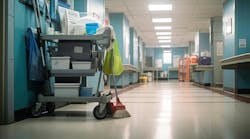The pandemic has been a reminder that cleaning is an essential strategy for protecting student and staff health. But perhaps the most glaring challenge is simply finding enough custodians to do the job.
In September 2021, the U.S. Bureau of Labor Statistics found about 314,900 openings for janitors and building cleaners are projected each year, on average, over the decade. Custodians, like other service workers, are looking for jobs that pay better, offer better hours, and are less physically demanding. That leaves schools and universities scrambling to meet their needs.
Here are three recommendations to help fill those needs.
1. Retaining current custodial staff members: Start by retaining existing staff. Schools and universities used to be able to compete for and retain top custodial talent with higher wages, superior benefits and greater opportunities for advancement; but today, the competition has increased.
If improving pay and benefits is not possible at this time, at a minimum, schools should make existing staff members know that they are important and valued. One approach is to increase efforts to protect their health. For example, reevaluate cleaning chemicals to determine if there are newer options using greener cleaning chemicals that can further reduce the risk of harm to custodians.
Also, keep in mind that the number one cause of missed-work days for custodial workers is ergonomic issues, often related to using tools that are either too big or small, too light or heavy, too short or long, etc., forcing custodians to bend, lift and reach in ways that cause injuries to their backs, shoulders, knees, arms and hands.
Using greener chemicals and addressing ergonomic issues are opportunities that can be addressed relatively easily and will be appreciated by current and future custodial staff members.
2. Finding more resources: Because cleaning is primarily a labor-based activity, finding additional resources may be key to effective and thorough cleaning. So get creative by working with administrators, principals, teachers and other staff to encourage students to participate in creating cleaner and healthier facilities.
Don't ask students to strip floors or disinfect restrooms, but there are plenty of opportunities that can save custodians time and free them up to do the tasks that only they should do.
For example, students should be asked at the end of class to pick up around them. In just a few minutes, a classroom of students can pick up materials from the floors, push in chairs, straighten desks and other activities that could take a single custodian 15 or more minutes each day. Multiplying this by every classroom a custodian has to clean and real resource savings can be found. Plus, picking up, straightening up and cleaning up after oneself is a great lesson to teach students.
3. Building community support: Retaining custodians and getting students and staff to create resource savings are great short-term operational opportunities; but in the end, schools and universities need to budget more for cleaning and maintenance.
It is essential that the custodial department make the case for more funding. Issues such as increasing teacher salaries, acquiring leading-edge technologies, upgrading physical infrastructures (which desperately need it) are competing for limited dollars; unless custodial voices are heard and addressed, cleaning will remain a underfunded problem for the next decade to come.
So look for both internally and externally for support. Although it may be inappropriate to “campaign” for more budget, vendors and motivated community members certainly can help. And the need to create healthful, high-performing buildings is real and will have a positive effect on students and staff health, as well as on educational outcomes.


